Planning Your Retaining Wall Project
What affects retaining wall design? Consider the possibilities.
Having a detailed site plan that is drawn to scale will help foresee design and construction challenges and provide an accurate reference for estimating your project. This will become your working or approved plans for the project.
Lot Lines
Your city hall will have a copy of your lot survey on file. The survey will not only identify property lines, but will provide an accurate scaled template of your site to help with planning.
Utilities
Buried utility lines are not only dangerous, they may prevent you from locating your landscape project where you want. Call the local utility companies and have these lines marked.
Permits
Building permits may be required if the retaining wall is above a certain height. Check to see what your local city code requires. An approved engineered wall design or an Allan Block pre-engineered solution may be needed in order to get a building permit. Contact your local AB Dealer for more details.
Neighbors
It's always nice (and smart too) to let your neighbors know about your project before you begin.
On-Site Soils
Clay soils put more pressure on a wall than sandy soils because they hold moisture. Identify the soils at your site.
To identify the soils, a good test is to pick up a small handful of the soil in the palm of your hand and squeeze it to form a ball. Take a sample from at least 12 in.(300 mm) below the surface.
Clay Soils
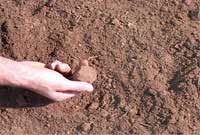
Clay Soils
Clay soil will stick together to form a ball. Clay soils retain moisture which will add pressure behind the walls. Typically most soils will be classified as clay and can be used in your project. However, they may require additional reinforcement.
Sandy Soils

Sandy Soils
Sandy soil, will not stick together because they are granular with no silty fine particles. These soils allow for good drainage and are ideal for building walls.
Organic Soils
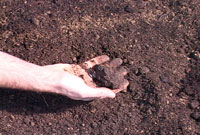
Organic Soils
Organic soils will stick together but will not hold once the pressure is released. They should only be used to finish off the top 8 in. (200 mm) of a wall. NEVER use organic soils to build the wall.
Learn more on working with soils on your project site.
Vegetation and the Environment
Existing trees and other vegetation can be designed into the wall layout as needed. New plantings can be added to enhance the total landscape. Any plantings directly behind the wall need to be done carefully as not to disturb any reinforcement that may have been added when the wall was built.
The Base or Foundation
You must build on solid ground. If your site has soft, wet soils, or if the area was previously excavated, the foundation’s soil may need to be replaced with good base materials and firmly compacted.
Determining Wall Height
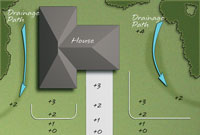
Determining retaining wall height
A detailed understanding of the site elevations and grade changes are needed to determine wall heights. Starting at the lowest point, mark your grade changes in 1 ft. (0.3 m) increments on the plan. Sketch in the drainage patterns.
Cut and Fill
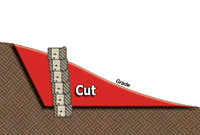
Cut Site
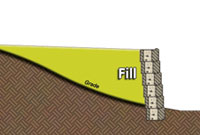
Fill Site
If building on a hill or a slope, the placement of your wall will determine how much soil will need to be removed or brought onto the site
A cut site is where you cut into the hillside and remove the soil. You will need to decide ahead of time what will be done with the excess soil.
A fill site is where you will need extra soils to fill in behind the entire wall. You will need to plan ahead to have good backfill materials brought onto the site.


